Lal R., Shukla M.K. Principles of Soil Physics
Подождите немного. Документ загружается.

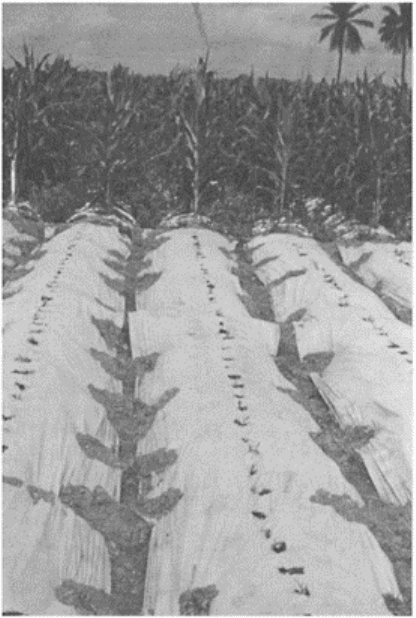
FIGURE 15.9 Clear plastic mulch
used on a ridged seed bed. Note holes
in the plastic for seedling emergence.
Principles of soil physics 424
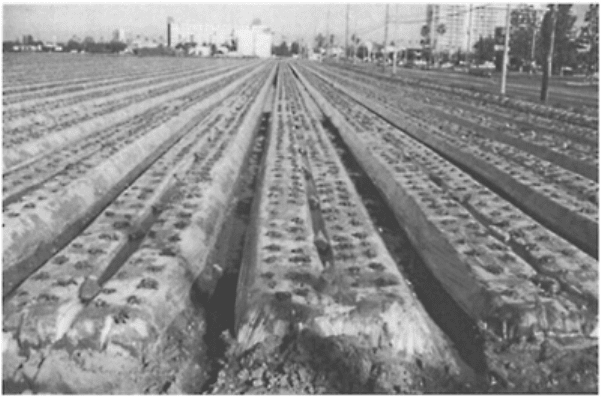
FIGURE 15.10 Black plastic mulch to
conserve water and control weeds in
strawberries grown in California.
airflow through the vegetative mulch is also high. A mulch of small thickness may be
mostly ineffective. Vegetative mulches are light colored and reflect most of the incident
radiations. Therefore, the initial evaporation rate under mulch is generally less. Gravel
mulching is a common practice of water conservation, as it enhances the infiltration and
simultaneously suppresses evaporation and reduces erosion of soil. Disadvantages of
gravel mulch are that gravel cannot be removed from the field after application and can
adversely affect future land uses.
15.5.2 Tillage
Among the various soil management practices for weed control and seedbed preparation,
tillage is an important technique of soil manipulation. Tillage operations generally result
in opening up of soil, changes in structure, loosening of tilled soil, and compaction of soil
immediately below the tilled layer (Fig. 15.13) (Lal 1989, 1990). The opening of the
topsoil enhances the evaporation from the tilled soil layer. However, the compaction of
layers underneath might reduce the upward transmission of water and subsequently make
the water availability limiting and reduce evaporation. The reduction of diffusivity in the
soil layer also reduces the evaporation. The discontinuity of pore channels due to the
Soil water evaporation 425
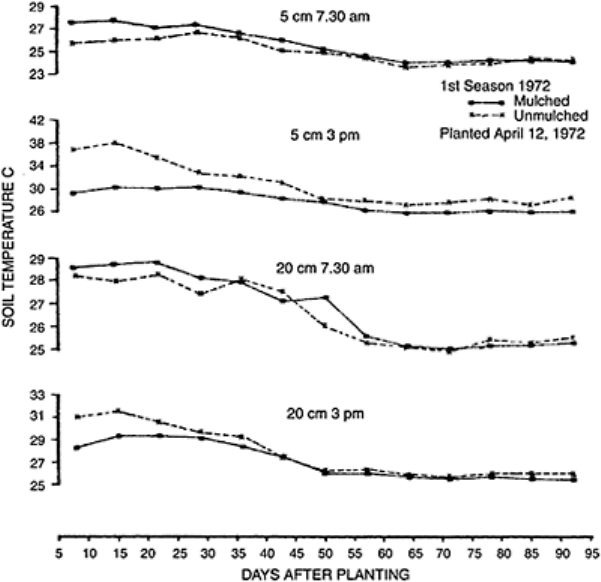
FIGURE 15.11 Effects of mulching
on soil temperature under maize.
(From Lal, 1974.)
tillage operations does not reduce the upward flow of water and does not reduce the total
evaporation. More recent trends have indicated that management practices involving
minimum tillage are better for efficient soil management. The tillage is beneficial under
two situations: (i) in soils with high swell-shrink capacity and where frequent wetting and
drying produces cracks. These cracks are the sources of secondary evaporation from soil.
Cultivation may prevent development of or help obliterate cracks, (ii) Tillage eliminates
weeds and may reduce the rate of application of herbicides. Burning crop residue and the
presence of ash on the soil surface can influence soil temperature by altering albedo and
soil moisture regime (Figs. 15.14 and 15.15).
Principles of soil physics 426
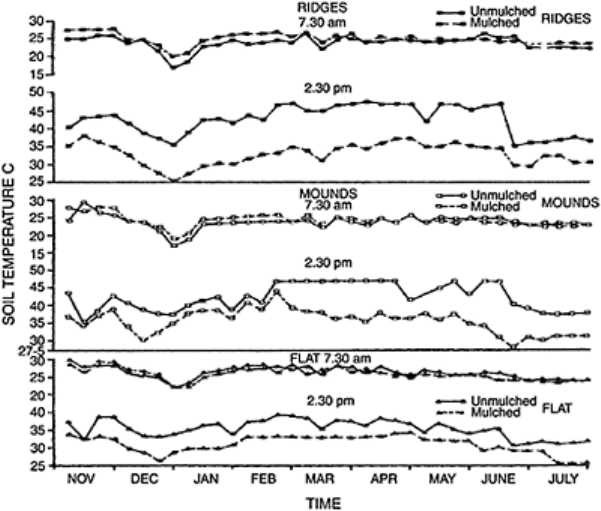
FIGURE 15.12 Effect of mulching
and methods of seedbed preparation on
soil temperature under yams. (From
Lal, 1974.)
15.5.3 Conservation Tillage
Conservation tillage practices leave a high percentage of the residues from previous crops
on the soil surface (Fig. 15.16). Plant residues left on the soil surface are effective in
reducing evaporation and conserving soil moisture. A conservation tillage practice widely
used in semiarid and humid regions is stubble mulching where wheat stubbles or corn
stalks from previous crops are uniformly spread over the soil surface. The land is then
tilled with special implements, which leave most of the residue on the soil surface. The
next crop is planted through the stubble, which results in a healthy environment
(temperature, water, and air) for seed germination. No tillage, or zero tillage, is another
conservation tillage system that leaves residue on the soil surface and a new crop is
planted directly through the residue of the previous crop with no plowing or disking (Lal,
2003).
Soil water evaporation 427
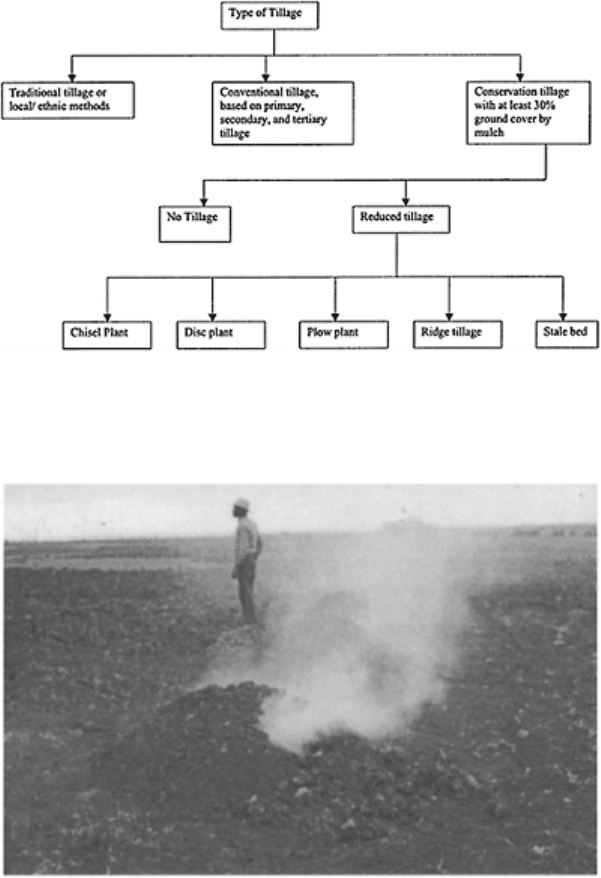
FIGURE 15.13 Types of tillage
methods. (Modified from Lal, 1989;
1990.)
FIGURE 15.14 Burning crop residues
in a mounded seed bed in Ethiopia.
Mounded seedbed alters soil
temperature and affects evaporation
rate.
Principles of soil physics 428
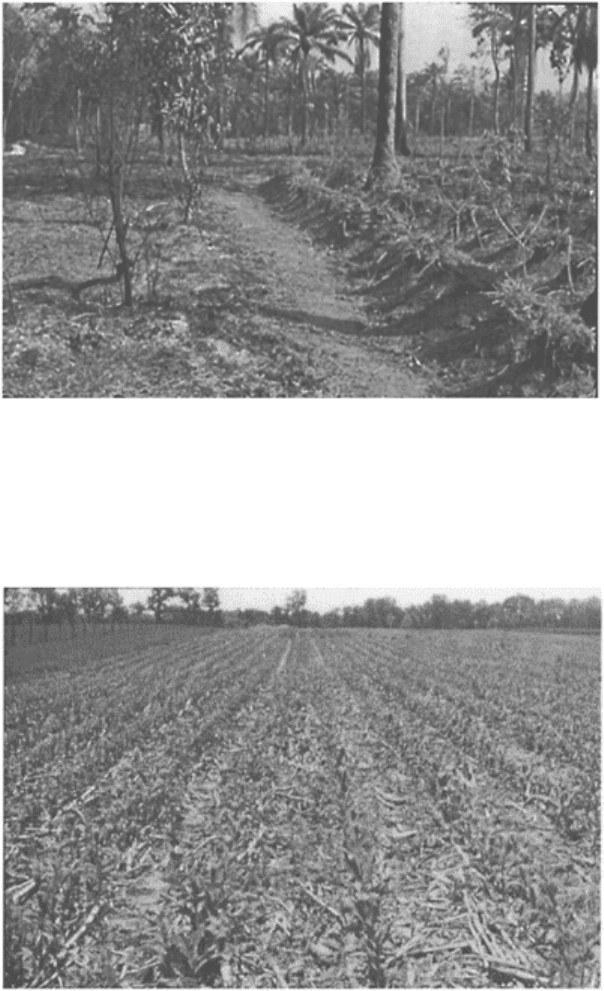
FIGURE 15.15 A mulch cap on yam
mounds decreases soil temperature and
reduces evaporation (right), while ash
from crop residue alters albedo and
soil temperature.
Soil water evaporation 429
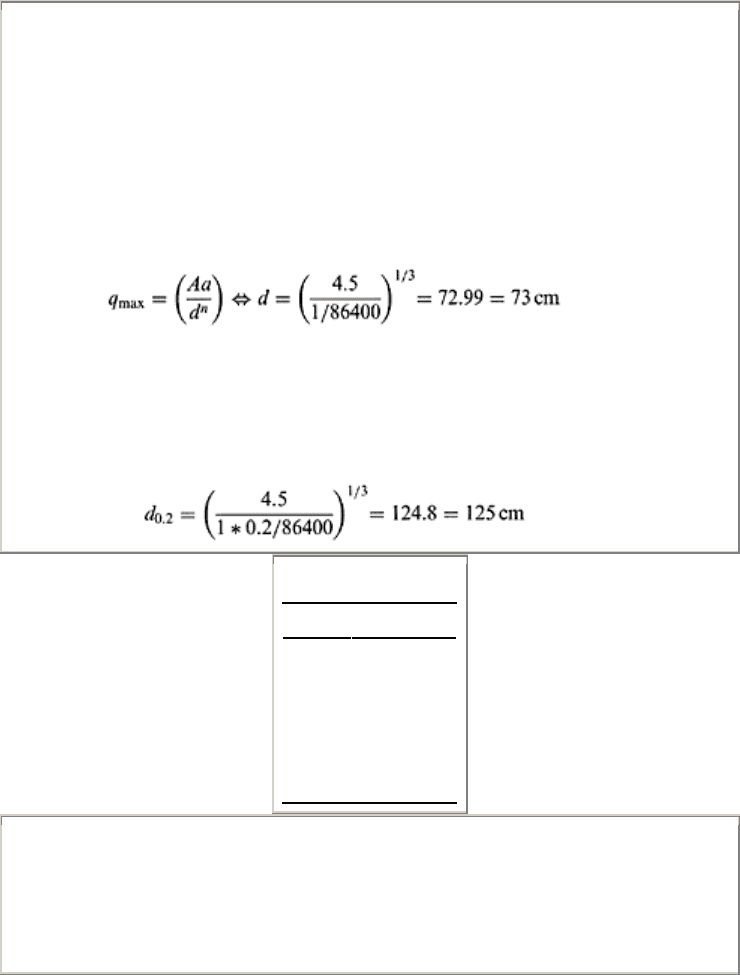
FIGURE 15.16 No-till farming with
crop residue mulch reduces soil
evaporation.
Example 15.1
Assume average daily steady state evaporation is 1 cm in a saturated loam soil in a high
water table area. Estimate (a) threshold depth beyond which water table must be lowered,
(b) water table depth at which evaporation will fall to 20% of potential value, and (c) plot
daily evaporation rate with respect to water table depth. Use Eq. (15.10), assuming Aa to
be equal to 4.5 cm
2
.sec and n=3.
Solution
According to Eq. (15.10)
where d is the maximum depth of water table below the soil surface, which can supply
water to maintain a steady flux for evaporation. Hence
(a) Threshold water table depth is 73 cm.
(b) The water table depth (d
0.2
) at which evaporation rate falls by 20% can be calculated
from again Eq. (15.10) as follows:
(c)
D (cm) q
max
(cm)
0–73 1
80 4.5/80
3
=0.76
90 4.5/90
3
=0.53
100 0.39
120 0.23
Example 15.2
Consider an infinite sandy loam soil profile, which is initially saturated with water. The
initial moisture content of soil is 0.52 cm3 cm−
3
and final moisture content of 0.2 cm
3
cm
−3
If weighte
d mean diffusivity of soil is 80 cm
2
d
−1
calculate evaporation and the
Principles of soil physics 430

evaporation rate for each day during the next 10 days.
Solution
From Eq. (15.21) the evaporation rate (e), and from Eq. (15.22), the cumulative
evaporation (E), can be calculated for days 1, 2, 3... 10 as follows:
Mid-day e (cm d
−1
) Day E (cm)
0.5 2.28 1 3.23
1.5 1.32 2 4.57
2.5 1.02 3 5.59
3.5 0.86 4 6.46
4.5 0.76 5 7.22
5.5 0.69 6 7.91
6.5 0.63 7 8.54
7.5 0.59 8 9.13
8.5 0.55 9 9.69
9.5 0.52 10 10.21
PROBLEMS
1. If the composite coefficient Aa is 4.5 cm
2
/s, n=3, potential rate of evaporation is 8
mm/d to what depth must the water table be lowered for reducing evaporation? Also
calculate the watertable depth at which the evaporation rate drops by 10%, 30%, and 70%
of potential evaporation rate.
2. Assume an infinitely deep, saturated sandy loam soil profile under very high
evaporativity. If initial volumetric water content of soil is 0.50, final volumetric water
content is 0.10 and weighted mean diffusivity is 2×10
4
mm
2
d
−1
. Calculate the evaporation
and evaporation rate, for the next 6 days.
3. If an impermeable layer exists at the end of a uniform wetted soil of depth 1.2 m,
initial volumetric water content (θ
o
) 0.24, and initial diffusivity (D(θ
o
)) 4×10
4
mm
2
d
−1
. If
evaporativity is 10 mm/d, calculate evaporation rate during the first 10 days if diffusivity
(D(θ)) is given by Eq. (15.17) are assuming B=15, calculate D(θ
o
) for the next 6 days.
4. Briefly outline techniques of regulating soil evaporation and explain the principle of
their effectiveness in reducing evaporation.
5. What should be the irrigation strategy in arid environments and why?
Soil water evaporation 431
REFERENCES
Hatano R., H. Nakamoto, T.Sakuma, and H.Okajima (1988). Evapotranspiration in cracked clay
field soil. Soil Sci. Plant Nutr. 34:547–555.
Gardner W.R. (1958). Some steady state solutions of the unsaturated moisture flow equation with
application to evaporation from a watertable. Soil Sci. 85(4): 228–232.
Crank J. (1956). The mathematics of diffusion. Oxford University Press, London and New York.
Fisher R.A. (1923). Some factors effecting the evaporation of water from soil. J. Agr. Sci. 13:121–
143.
Gardner W.R. (1959). Solutions of the flow equation for the drying of the soils and other porous
media. Soil Sci. Soc. Am. Proc. 23:183–187.
Gardner W.R. and D. Hillel (1962). The relation of external evaporative conditions to the drying of
soils. J. Geophys. Res. 67:4319–4325.
Gardner W.R. and M.S.Mayhugh (1958). Solutions and tests of the diffusion equation for the
movement of water in soil. Soil Sci. Soc. Am. Proc. 22:197–201.
Hillel D. (1976). On the role of soil moisture hysteresis in the suppression of evaporation from bare
soil. Soil Sci. 122:309–314.
Hillel D. (1980). Fundamentals of soil physics. Academic Press, New York.
Hillel D. and C.H.M.van Bavel (1976). Dependence of profile water storage on soil hydraulic
properties: a simulation model. Soil Sci. Soc. Am. J. 40:807–815.
Jackson R.D., B.A.Kimball, R.J.Reginato, and S.F.Nakayama (1973). Diurnal soil water
evaporation: comparison of measured and calculated soil water fluxes. Soil Sci. Soc. Am. Proc.
38:861–866.
Lal R. (1974). Role of Mulching Techniques in Tropical Soil and water management. Tech.
Bulletin no. 1, International Institute of Tropical Agriculture, Nigeria.
Lal R. (1989). Conservation tillage for sustainable agriculture. Adv. Agron. 42: 85–197.
Lal R. (1990). Soil erosion in the tropics: Principle and Management. McGraw Hill Book Co., 579
pp.
Lal R. (1991). Soil Structure and sustainability. Journal of sustainable Agriculture. 1(4): 67–92.
Lal R. (2003). Historical development of no-till farming. In R. Lal, P. Hobbs, N. Upof
l
, and D.O.
Hansen (eds) Sustainable agriculture and the rice wheat system. Marcel Dekker, New York.
Milley P.C.D. (1984). A linear analysis of thermal effects on evaporation from soil. Water Resour.
Res. 20:1075–1086.
Moore R.E. (1939). Water conduction from shallow watertable. Hilgardia 12: 383–426.
Pearse J.F., T.R. Oliver, D.M. Newitt (1949). The mechanisms of the drying of solids: Part I. The
forces giving rise to movement of water in granular beds during drying. Trans. Inst. Chem. Eng.
(London) 27:1–8.
Philip J.R. (1957). Evaporation, moisture and heat fields in soil. J. Meteorol. 14: 354–366.
Ripple C.D., J. Rubin, and T.E.A. van Hylckama (1972). Estimating steady state evaporation rates
from bare soils under conditions of high water table. US Geol. Surv. Water-Supply Paper 2019-
A.
Rose C.W. (1966). Agriculture Physics. Pergamon Oxford.
Willis O.W. (1960). Evaporation from layered soils in presence of a watertable. Soil Sci. Soc. Am.
Proc. 24:239–242.
Principles of soil physics 432
16
Solute Transport
16.1 INTRODUCTION
Water entering the soil profile from rain or irrigation is essentially a dilute solution.
Rainwater is pure when it condenses to form clouds; during descent it absorbs
atmospheric gases (i.e., CO
2
, N
2
, products of sulfur and O
2
, etc.). When water flows on
soil surface as overland flow and/or through the soil matrix, it also dissolves solutes (e.g.,
salts, fertilizers, pesticides). These solutes not only move with soil water but also within
the soil matrix mainly due to the concentration gradients. Sometimes, solutes react among
themselves and/or with soil material according to a range of physical and chemical
processes.
In agricultural ecosystems, solutes may be categorized on the basis of their function
(e.g., nutrients, pesticides, waste compounds, salts, organic chemicals, heavy metals,
viruses, and bacteria). Understanding transport of solutes in soil is important to many
management problems in agriculture. It can help when developing procedures for
maximizing the effective use of fertilizers or pesticides and other chemicals within the
root zone while minimizing their movement into groundwater. Knowledge of these
processes is important to understanding the problems of contamination of natural water
through leaching or redistribution within a vadose zone to groundwater, availability of
solutes for plant uptake, surface runoff, salt intrusion in coastal aquifers, seepage from
storage or disposal systems, and chemical residues.
Depending upon chemical stability and reactivity, the solutes are broadly classified
into two categories: (i) conservative solutes, which remain unchanged physically and
chemically, and do not undergo irreversible reactions, such as chloride (Cl) and bromide
(Br); and (ii) nonconservative solutes, which can undergo irreversible reactions and
change their physical or chemical phase. The nonconservative solutes can be divided into
labile solutes and reactive solutes. The labile solutes can undergo reversible or
irreversible physiochemical, biochemical, or microbial reactions and can change their
physical or chemical phase with time. The examples of labile solutes are: nitrate, sulfate,
and ammonia, which are involved in mineralization, immobilization, or redox reactions.
Some pesticides are also labile and their lability is quantified by their half-life (White et
al., 1998). Reactive solutes undergo reversible or irreversible reactions with soil
constituents by way of adsorption (adsorption of cations, e.g., Ca
+
, Mg
++
, on clay
particles), precipitation or dissolution (e.g., precipitation of calcium as calcium sulfate or
